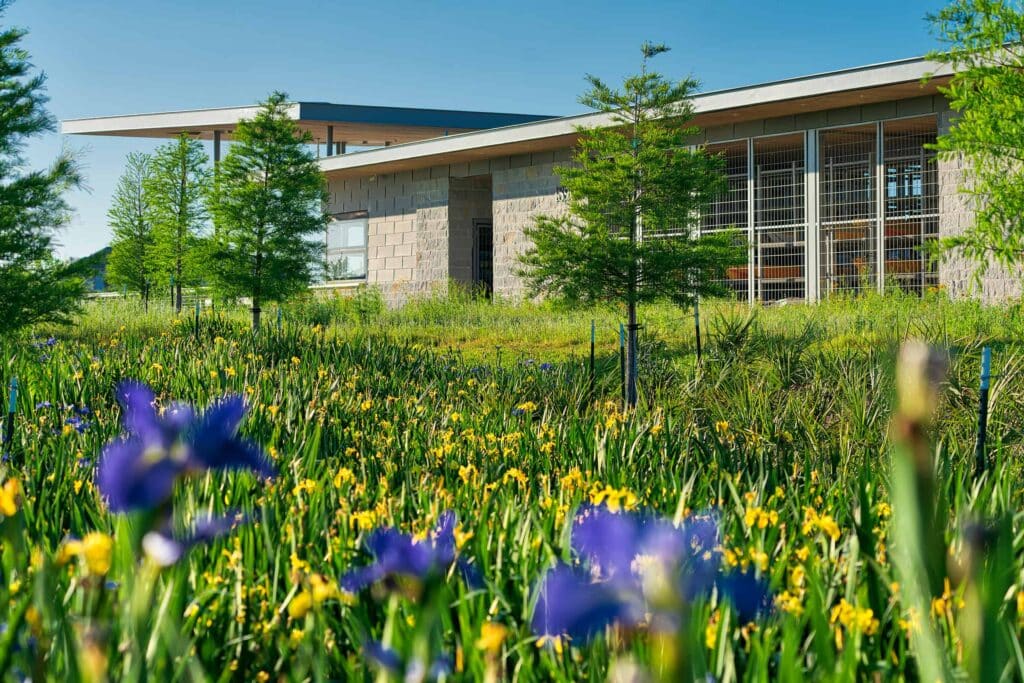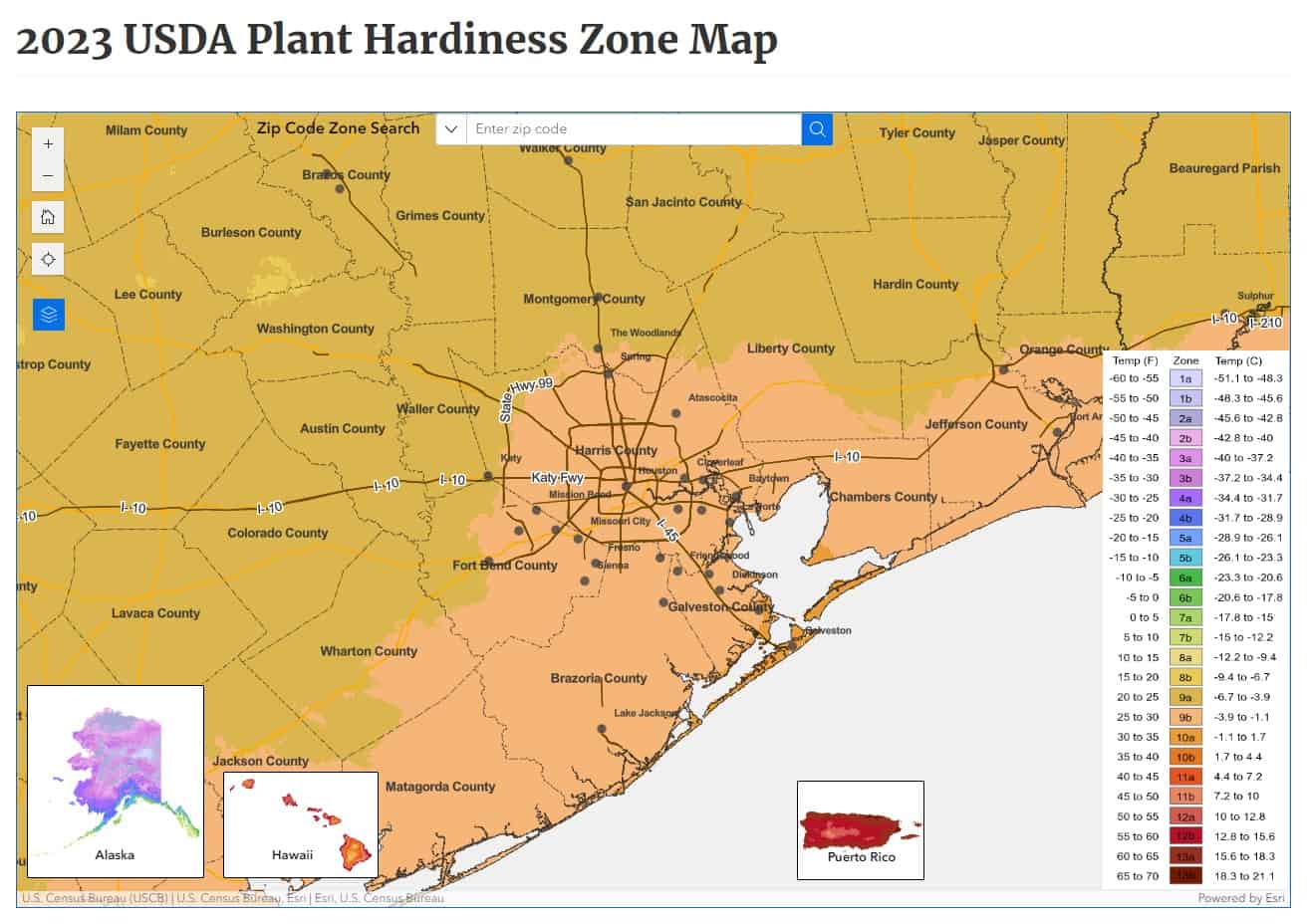BEST PRACTICES
PLANTING CONSIDERATIONS FOR A RESILIENT LANDSCAPE
Author: Mary Keilers, Innovation & Research Principal
This article discusses the shift towards horticulturally resilient native plants to enhance urban landscape durability and adaptability in the face of evolving environmental challenges.

Overview
Recent climate events underscore the evolving environment landscape architects must now navigate. In November 2023, The USDA released an updated Planting Hardiness Zone Map, shifting the City of Houston's classification from Zone 9a to 9b. The new boundary between these zones closely parallels the Grand Parkway’s alignment to the west and north. This reclassification indicates that Houston's average winter temperatures are now approximately 2.5 degrees warmer than those recorded for the previous hardiness zone map issued in 2012. However, recent severe weather events, such as Winter Storm Uri in 2021 and Winter Storm Elliott in 2022, have demonstrated that isolated major weather events can result in dramatic temperature changes, often reducing temperatures well below the average. These significant weather challenges, combined with the reflective heat and urban heat island effect found within cities, place additional strain on the landscape.
Navigating these complexities poses distinct challenges, causing area landscape architects to search for horticulturally suitable plants capable of enduring intense weather events. Trees and shrubs that once thrived under previous conditions are now struggling to adapt to the current climate. Thus, preserving the genetic diversity of native plants is essential for ensuring their adaptability to climate change.
Concerns have arisen that cultivars of native plants may not provide the same long-term ecological benefits as their naturally occurring counterparts, as evidenced by variations in performance among horticulturally developed woody ornamentals where cultivars of the same species have not performed uniformly. In developing cultivars, the nursery industry often selects specific traits to perpetuate, such as bloom color or plant habit. However, this selective breeding process can lead to the loss of genetically important characteristics, including cold tolerance and hardiness. This occurrence is illustrated by the varying survival rates among woody ornamental varieties in the latest freeze. A study conducted at Stephen F. Austin State University involved an assessment of freeze damage at the SFA Gardens. This research documented the impact on woody ornamental plants and highlighted species that either exhibited minimal damage or suffered significantly from the weather event. Species demonstrating high survivability rates were predominantly native to the region while non-natives lacked cold tolerance and experienced a wider range of failure amongst cultivars. Insights from this study, among others, are assisting Clark Condon in refining our plant selection process to create landscapes that are both durable and resilient.
Even beyond addressing extreme temperatures, urban challenges, and other environmental considerations, strategic planting design can significantly enhance the resiliency of the urban environment. This enhancement comes through habitat creation, carbon sequestration, and flood impact mitigation, largely accomplished by incorporating native species into project sites. These species have naturally adapted to the local environment, including its weather, soil, and rainfall, making them crucial for supporting local wildlife.
HABITAT CREATION
A 2019 UN Environment Programme article highlighted a concerning trend, citing that 40% of insect species are at risk of extinction, with populations rapidly declining. While insects are widely recognized for their role in pollination, their importance extends to maintaining soil structure, which is crucial for overall plant health. Therefore, it's essential for planting designs to include species that bolster insect populations. This approach will not only support a thriving insect community but also contribute to a healthy, functional landscape offering significant ecosystem benefits.
When selecting plant species to support insect populations, it's critical to provide keystone species. Per the Garden for Wildlife by National Wildlife Federation, these species are native plants that play a significant role “…to the food web and [are] necessary for many wildlife species to complete their life cycle.” Keystone species are categorized into two types: generalist and specialist. Plant-eating insect species that are specialists rely on specific host plants for food, while generalists utilize a wide range of plant species. Dr. Doug Tallamy with the University of Delaware’s Entomology and Wildlife Ecology Department has developed a list for the local region with several keystone species that are particularly beneficial for supporting butterfly, moth, and bee populations. For instance, the genus Quercus, commonly known as oaks, supports 253 species of caterpillars. Similarly, Gaillardia, also known as blanketflower, ranks among the top thirty native host plants for providing pollen to specialist bees. By understanding the specific role each species plays, landscape architects can design urban habitats that foster greater biodiversity and support insect populations.

Flood Impact Mitigation
Plant selections can also play a pivotal role in mitigating stormwater runoff, particularly in the Gulf Coast region where clay soil is prevalent. Unlike other parts of the country where low-impact development strategies might include the installation of permeable pavers, clay soils hinder adequate water infiltration from permeable paving systems. Therefore, alternative strategies are necessary to enhance infiltration. One effective strategy involves planting native grasses. These grasses offer benefits beyond supporting local insect and wildlife populations; their extensive root systems also aid in facilitating water infiltration into the soil. In response to this need, the Harris County Flood Control District has collaborated with Texas A&M Kingsville and Houston Wilderness to develop a native seed mix tailored to the southeast Texas region. Released by growers in the fall of 2023, this seed mix was trialed across various soil types and conditions. It was selected for its high germination rate, erosion control capabilities, and suitability for green infrastructure projects throughout the region. The success of this collaboration underscores the importance of innovative, nature-based solutions in urban flood management and highlights the critical role of native plants in enhancing community resilience.

Carbon Sequestration
The construction industry is responsible for 37% of global emissions, making it the world's largest source of greenhouse gases. It is imperative to identify strategies that can help offset these emissions. One effective approach is the integration of native plants into construction projects. Forest carbon projects, known for either preserving existing forests or planting new ones, are widely recognized. However, the significance of grasslands has recently been acknowledged as a crucial ecosystem that functions as a carbon sink. Unlike trees, grasslands store the majority of their carbon in the soil. This understanding is shaping the management strategies for grasslands and rangelands to maximize their carbon sequestration benefits. Historically, the Houston region was dominated by the Gulf Coast Prairie. By incorporating this prairie landscape into new developments, we can leverage the natural carbon sequestration capabilities of the prairie system. Similarly, the creation of wetlands, another dominant ecosystem of the region, offers comparable benefits. Incorporating these types of plant ecosystems into projects delivers numerous ecosystem service benefits.

SUMMARY
The shifting climate zones underscore a critical challenge and opportunity for urban development and environmental stewardship. Climate change trends also signal the pressing need for adaptive strategies in landscape design. Through careful consideration of local ecosystem dynamics, including the support of insect populations and the management of stormwater runoff, we can create more sustainable urban spaces. The collaborative efforts of organizations like the Harris County Flood Control District, Texas A&M Kingsville, and Houston Wilderness in developing native seed mixes for regional conditions exemplify the innovative approaches required to address contemporary environmental challenges.
By prioritizing native plant selections and ecosystems, we lay the foundation for a more resilient and vibrant future. Not only do these strategies mitigate the adverse effects of urbanization and climate change, but they also contribute to thriving habitats that support biodiversity and foster community wellbeing. As we move forward, we must continue to refine our approaches, drawing upon the latest research and best practices, to ensure that our landscapes and built environments reflect our commitment to sustainability.

